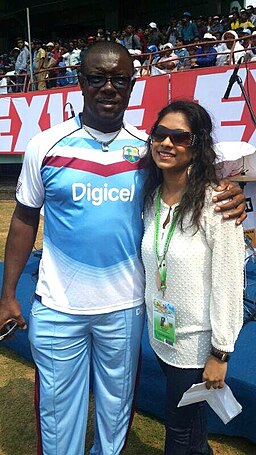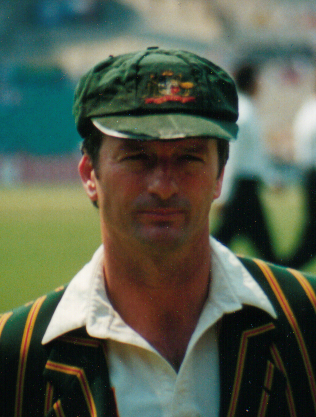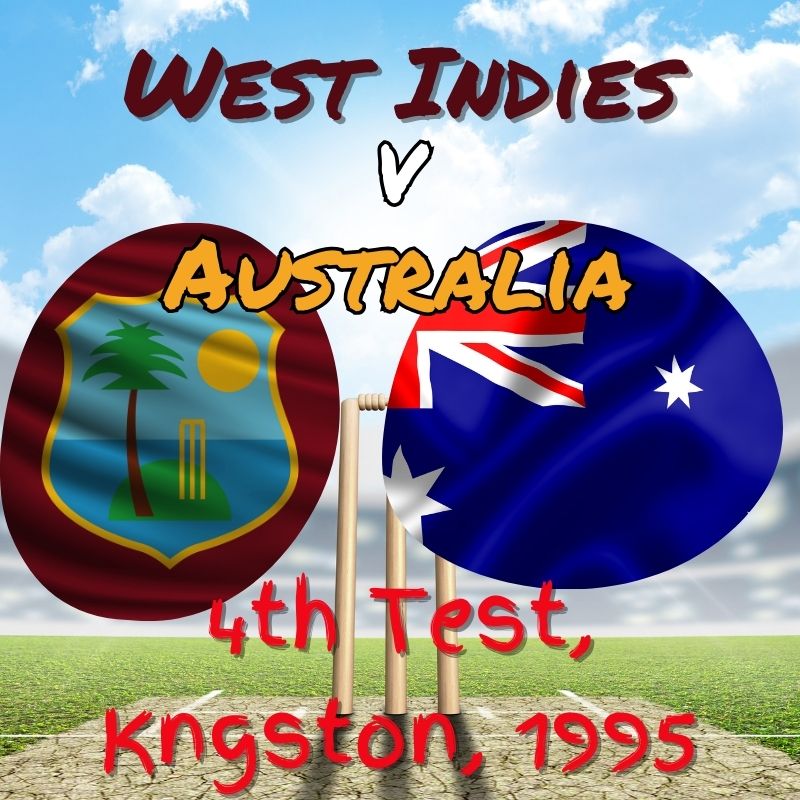As Australia headed into the 4th Test of the 1995 series against West Indies at Sabina Park, Kingston, the series was delicately poised at 1-all.
This was a critical moment for Australian cricket, as they sought to clinch the series and solidify their status as the world’s top team.
Having already won two Tests convincingly, Australia had demonstrated their superiority with a well-balanced team boasting both strong batting and a formidable bowling attack.
The West Indies, long the dominant force in world cricket, were under significant pressure to defend their home turf and avoid a series defeat. Traditionally unbeatable at home, they now faced the real possibility of losing a Test series in the Caribbean for the first time in over a decade.
Sabina Park in Kingston, Jamaica, is renowned for its pace and bounce, conditions that historically favour fast bowlers. Both teams possessed strong pace attacks, with Australia’s Glenn McGrath and West Indies’ Courtney Walsh likely to relish the prospect of exploiting the lively pitch.
The surface was expected to offer assistance to the quicks early on, but as the match progressed, the pitch was likely to deteriorate, making batting increasingly challenging. These conditions set the stage for an intense contest where the ability to handle pace and bounce would be crucial.
West Indies’ First Innings
West Indies posted a total of 265 runs in their first innings, largely due to a resilient century from their captain, Richie Richardson. Battling both the Australian bowlers and challenging conditions at Sabina Park, Richardson’s 100 off 222 balls was a masterclass in patience and determination.

Richie Richardson Littleflower01, CC BY-SA 3.0, via Wikimedia Commons
Opening the batting, and with fellow opener Stuart Williams out second ball for a duck, Richardson held the innings together, showcasing his experience and leadership. His innings was marked by a mix of solid defence and selective aggression, crucially anchoring the West Indian innings as wickets tumbled around him.
Richardson’s ability to withstand the pressure and craft a century was vital in giving his team a fighting chance in the match.
Brian Lara, the other key contributor, played a contrasting innings to Richardson’s measured approach. Lara’s 65 off just 78 balls was a display of aggressive intent, as he took the attack to the Australian bowlers.
His fluent stroke play and quick scoring provided the momentum that the West Indies desperately needed. Richie Richardson and Lara took West Indies to 103 before Lara was caught by wicketkeeper Healy off Shane Warne.
A couple of the other West Indian batsmen produced starts – Jimmy Adams (20), Carl Hooper (23) and Keith Arthurton (16) – but none stayed with Richie Richardson long enough for the West Indies to produce a truly competitive innings.
Australia’s bowlers, led by Paul Reiffel, were relentless throughout the innings. Reiffel’s disciplined bowling earned him figures of 3/48. His ability to maintain tight lines and extract movement from the pitch kept the West Indian batsmen in check. The Australian bowlers, as a unit, ensured that the West Indies couldn’t build substantial partnerships, ultimately restricting them to a subpar total.
Australia’s First Innings
Australia responded to the West Indies’ total with a commanding innings of 531 runs, led by an outstanding double century from Steve Waugh. His 200 off 425 balls was a testament to his incredible patience, grit, and determination.
Waugh’s innings was a masterclass in how to build a Test innings, as he meticulously accumulated runs while holding the Australian innings together. Coming to the crease at a time when Australia were in trouble at 3/73, Waugh played with composure, managing the West Indian bowlers with skill and confidence.
His ability to withstand the pressure and bat for such an extended period not only wore down the bowlers but also set a solid platform for Australia’s dominance in the match. His knock was particularly significant in the context of the series, underscoring his reputation as one of Australia’s most reliable and resilient batsmen.

Mark Waugh paddynapper, CC BY-SA 2.0, via Wikimedia Commons
Mark Waugh, Steve’s twin brother, provided the perfect foil with an elegant innings of 126 off 192 balls. Known for his effortless stroke play, Mark’s innings was characterized by his stylish drives and cuts, which demoralized the West Indian bowlers.
While Steve Waugh’s approach was more about grit and survival, Mark’s innings was about class and timing, making their partnership a crucial element of Australia’s formidable total. Together, the Waugh twins took the score from a precarious 3/73 to a commanding 4/304, already 39 runs ahead, with six wickets remaining.
For both Waugh brothers, this was their 8th test century, and it is hard to imagine any being more important.
Once Mark Waugh was dismissed, Greg Blewett came in. His 69 off 130 meant that Australia were able to build on a commanding position rather than lose a couple of quick wickets and give the West Indies team a sniff. Their partnership of 113 meant that when the 5th wicket fell, Australia were 417, a lead of 162 with the wicketkeeper and bowlers to come.
Paul Reiffel (23) provided a stubborn partnership of 73 with Steve Waugh for the 8th wicket to really grind the West Indian attack into the dirt, and when Steve Waugh was the last Australian out, having just passed 200, Australia led by 266.
The West Indies’ bowlers struggled to contain the Australian batsmen on a pitch that offered little assistance. Courtney Walsh and Kenny Benjamin, who both claimed 3 wickets each, toiled hard but found it difficult to extract any real menace from the surface. Walsh, the experienced campaigner, bowled with his usual heart and determination, but even his best efforts couldn’t prevent the Australians from piling on the runs.
Kenny Benjamin’s pace was impressive, but he lacked the consistency needed to trouble the well-set Waugh brothers. The lack of support from the rest of the bowling attack and the unresponsive pitch made it a long and gruelling innings for the West Indies, highlighting the challenges they faced in trying to claw their way back into the match.
West Indies’ Second Innings
Facing a daunting deficit of 266 runs, the West Indies struggled in their second innings, managing only 213 runs before being bowled out. Nightwatchman, Winston Benjamin was the top scorer, displaying resilience with a fighting 51 off 118 balls. But despite his efforts, the West Indies found themselves unable to mount a significant recovery.
Paul Reiffel (4/47) tore the heart out of the West Indian batting, taking the first 3 wickets to fall, while Shane Warne (4/70) mopped up the West Indian innings, taking the last four wickets. Six of the West Indian batsmen scored between 13 and 20 runs, showing the relentless nature of the Australian bowling, and the difficulty of a pitch that was, perhaps, becoming difficult to bat on.
When Kenny Benjamin was the last man out, caught by Mark Taylor off the bowling of Shane Warne, West Indies had lost by an innings and 53 runs, and had lost the series 2-1.
Controversial Moments
This test was not without its share of controversy, particularly surrounding some of the umpiring decisions. One of the most debated moments occurred during the West Indies’ first innings when Brian Lara was given out for a duck in West Indies second innings.
The ball from Paul Reiffel appeared to be pitching outside leg stump, but Lara was adjudged LBW, sparking discussions among commentators and fans alike. This decision was crucial as West Indies needed Lara to score big, and his duck just before the end of play, seemed to demoralise the West Indian team.
There were other issues that weren’t umpiring related. Given the high stakes of the series, sledging and verbal exchanges were inevitable.

Steve Waugh, 2002 John P Darcy, Public domain, via Wikimedia Commons
Steve Waugh, known for his mental toughness and ability to engage in verbal duels, was involved in a few heated moments with the West Indian players, particularly Curtley Ambrose, who had to be held back by his team mates during one tense moment. These exchanges added to the drama and tension of the match, exemplifying the fierce rivalry between the two sides.
Legacy of the Match
The 4th Test in Kingston, 1995, marked a significant turning point in world cricket, symbolizing the end of the West Indies’ era of dominance. For nearly two decades, the West Indies had been the undisputed kings of cricket, with a fearsome lineup of fast bowlers and powerful batsmen.
However, this series defeat, capped by the loss in Kingston, highlighted the cracks that had begun to appear in their once invincible armour.
The loss exposed the aging core of the team and the lack of emerging talent to replace legends like Viv Richards, Malcolm Marshall, and others who had defined West Indies cricket for so long. This defeat prompted a period of introspection and eventually led to changes in the team’s composition and strategy, as they sought to rebuild and reclaim their place at the top.
Conversely, Australia’s victory in this Test and the series was pivotal in establishing them as the world’s preeminent cricketing nation.
The win in Kingston signalled the beginning of a new era where Australia would dominate international cricket for over a decade. Players like Steve Waugh and Shane Warne, who played crucial roles in this match, would go on to become central figures in Australia’s sustained success.
Waugh’s leadership and Warne’s brilliance were instrumental in transforming Australia into a cricketing powerhouse, with this series win being a key milestone on that journey.
For Richie Richardson, this match was part of the closing chapter of his illustrious career. He would play only one more tour of England, a six match tour that would end in a 2-2 draw.
As captain, he faced the daunting task of leading a team in transition, and this series defeat was a significant blow. It marked a tough end to his tenure as captain, as the psychological impact of losing at home was profound.
On the other hand, for the Waugh brothers, this match solidified their reputations as world-class cricketers. Steve Waugh’s double century and Mark Waugh’s elegant innings were defining moments that would be referenced throughout their careers.
Steve Waugh would play another 92 test matches, scoring 24 more test centuries (none of them passing this 200, which was his highest test score), and taking his average from 47.23 to 51.06 by the end. Mark Waugh would play another 80 tests, scoring 12 more centuries, and maintaining his average at around the 42 mark.
This match also reshaped the rivalry between the two teams, with Australia emerging as the new standard-bearers in world cricket, while the West Indies began a period of rebuilding and reflection.

